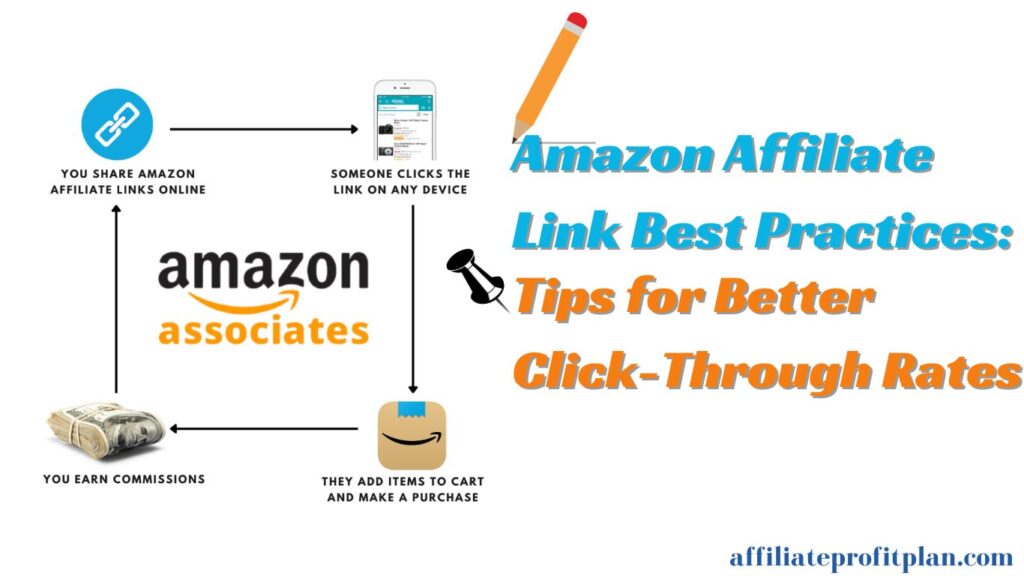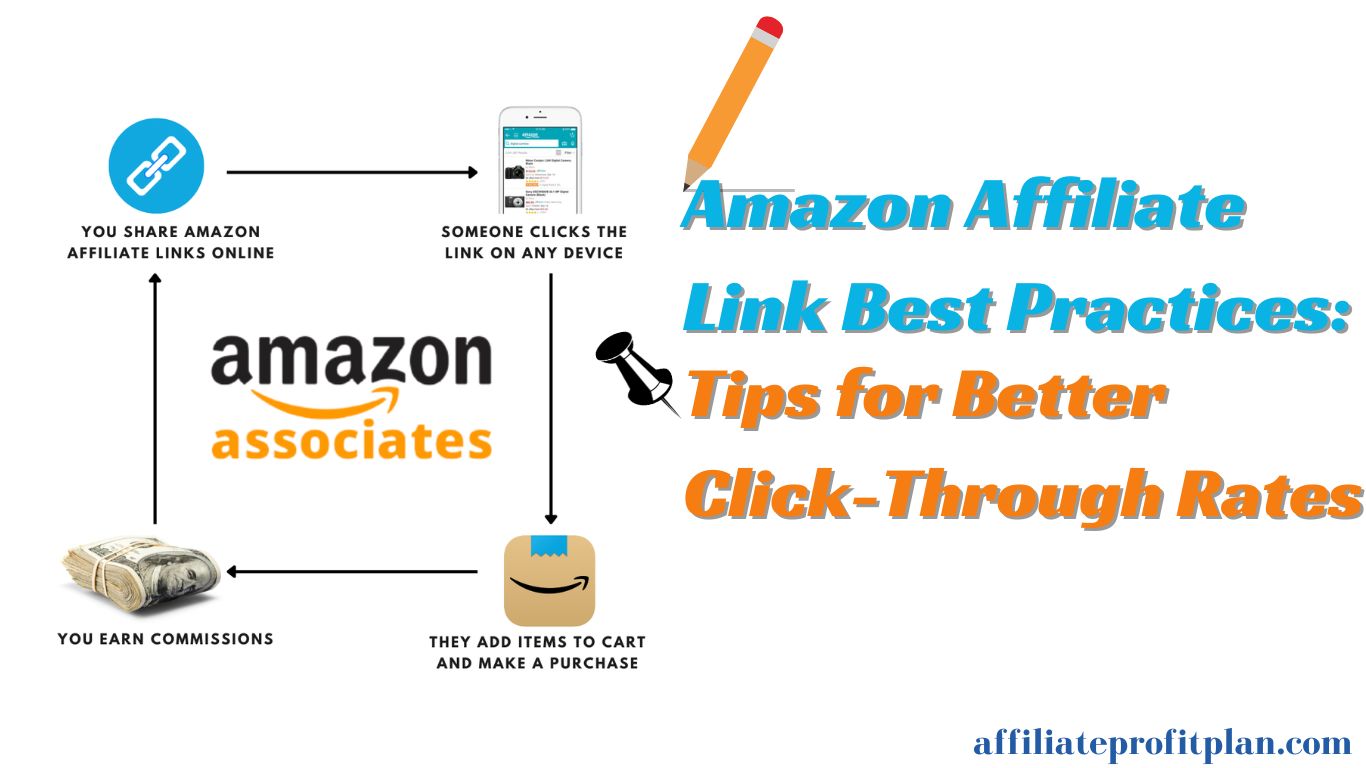Welcome to my article Amazon Affiliate Link Best Practices: Tips for Better Click-Through Rates. When it comes to Amazon Affiliate Marketing, there’s one simple truth: the more clicks, the more commissions. It’s like fishing—you can have the best bait in the world, but if it’s not in the right spot or at the right time, you’re just wasting your effort. That’s why optimizing your Amazon affiliate links is crucial to boosting your click-through rates (CTR) and, ultimately, your earnings. But don’t worry, you don’t need a Ph.D. in marketing to get it right. A few strategic tweaks here and there can make a world of difference, and we’re here to break it all down for you.
In this post, we’re going to dive into the best practices for optimizing your Amazon affiliate links so you can start raking in more clicks—and let’s be real, who doesn’t want that? We’ll cover everything from crafting irresistible calls-to-action (CTAs) to perfecting link placement, plus a few other tricks to make sure your affiliate links are as clickable as possible. Think of it like setting up a lemonade stand—you’ve got the perfect product (Amazon’s deals), but you’ve got to put it in the right spot with a sign that says, “Hey, come check this out!” So let’s get into it, shall we? Your affiliate earnings are about to get a serious upgrade.
Access My Proven Blueprint for $50-$100 Daily Income – Watch This FREE Video Now >>>

Tip #1:Use Clear and Compelling Calls-to-Action (CTAs)
Alright, let’s talk about Calls-to-Action (CTAs)—those little nudges that push your audience to take action. Think of a CTA like a friendly, well-timed shove in the right direction. If your Amazon affiliate links are your bait, then CTAs are your hook. Without them, your links might just be floating around in the ocean of the internet, waiting to be noticed. With a good CTA, however, those links will be as irresistible as a sale on a brand-new gadget.
A clear and compelling CTA does more than just tell people to click on a link—it creates a sense of urgency or curiosity. Phrases like “Get the best deal here!” or “Don’t miss out on this limited-time offer!” tell your audience exactly why they should click. But don’t just throw any CTA in there—think of it as a conversation with your reader. If you want them to click, make it about them. Instead of the generic “Click here,” which is about as exciting as a soggy towel, try something that speaks to their needs, like “Transform your home with these top-rated gadgets” or “Save big today on the best skincare products.”
Another key to a great CTA is clarity. Keep it simple and easy to understand. If your CTA sounds like it’s written in code or it’s too vague, your reader will likely keep scrolling. Phrases like “Shop now,” “See it for yourself,” or “Get yours before they’re gone” work wonders. Also, timing is everything. Place your CTAs where readers will naturally see them—think at the start of your post, within your content, and especially at the end as a final nudge.
Finally, remember: A CTA isn’t a one-size-fits-all deal. Test and tweak your CTAs to see what resonates with your audience. Maybe your crowd loves a sense of urgency or they prefer a softer, more helpful tone. Either way, a great CTA is about getting your readers to feel like they’d be missing out if they didn’t click. So, go ahead, put those irresistible CTAs to work, and watch those click-through rates skyrocket!
Tip #2:Strategically Place Affiliate Links Within Your Content
Let’s face it: placement is everything—whether you’re talking about the perfect parking spot, the best seat at a concert, or where to place your Amazon affiliate links within your content. Put them in the wrong spot, and your links might as well be invisible. But when placed strategically, they’ll be as hard to ignore as the smell of fresh-baked cookies.
First things first: location, location, location. The best place to start is near the top of your content. We’re talking within the first 100 words or so. People are busy, and if they’re reading your post, they’re looking for value right out of the gate. This is the prime real estate for your affiliate link, especially if you’re promoting something relevant to the subject you’re covering. For example, if you’re reviewing a kitchen gadget, throw in an affiliate link to buy it right after you mention it. It’s a no-brainer. Your readers are already interested, so give them the opportunity to buy while their interest is still fresh.
But don’t stop there! If you think your job is done after that first link, well, think again. You’ve got to keep the momentum going. Place links naturally throughout your post—think of them like breadcrumbs leading your readers to your affiliate offers. Don’t just drop them randomly like confetti; make sure they’re contextually relevant. For instance, if you’re writing a list of top-rated products, link to Amazon right when you mention each item. It makes sense, and it feels natural. Your readers won’t feel like you’re shoving sales in their face because you’re making their buying journey easier.
Now, let’s talk about the end game—the finish line. The best spot for a final affiliate link is at the end of your post. You’ve done the hard work of educating and engaging your audience, and now it’s time to gently guide them toward that “purchase” button. After all, they’ve read your entire post and are likely thinking, “Okay, I’m ready for the next step.” This is the moment to hit them with a clear, compelling CTA like, “Ready to buy now? Check out this amazing deal!” It’s like offering them a virtual shopping cart at the finish line—super convenient, and they’ll thank you for it.
Finally, let’s not forget about the middle ground—the sweet spot for strategically placing links. Use subheadings and sections in your content as natural breaks. These are prime locations to add an affiliate link without overwhelming your reader. Just make sure the link fits with the content—don’t try to shoehorn it in. If it flows naturally, you’ll have no trouble getting those clicks.
In the end, think of your affiliate links as the secret sauce that enhances your content, not distracts from it. Strategic placement ensures that your links don’t just sit there looking pretty—they actively guide your readers toward making a purchase. So go ahead, play real estate agent with your affiliate links, and watch your click-through rates rise.
Tip #3: Optimize Link Design for Better Visibility
Alright, let’s talk about link design—because, let’s face it, not all links are created equal. You’ve got your basic, barely-there hyperlinks, and then you’ve got the eye-catching, can’t-miss links that practically scream, “Click me!” (in the most polite and persuasive way possible, of course). If you want your affiliate links to get the attention they deserve, you’ve got to make them stand out. Think of your links like the VIP section at a club—they need to be visible, attractive, and easy to spot in a crowd.
Access My Proven Blueprint for $50-$100 Daily Income – Watch This FREE Video Now >>>
So, how do you do that without turning your content into a neon sign? Start by making your links visually distinct. Plain text links are a bit, well, boring. They blend in with the rest of your content like a wallflower at a party. Try using a different color for your links—nothing too flashy, just enough to make them pop against the rest of your text. Blue is a classic for links, but feel free to experiment with other shades, as long as they don’t hurt your readers’ eyes. A touch of color will make your links stand out, but it’ll still keep the design looking clean and professional.
Next up, underline those links. It’s a simple tactic, but one that immediately signals to your readers, “Hey, this is clickable.” Don’t go overboard with underlining every single word, though—remember, subtlety is key. Only underline your affiliate links so that they’re easy to find but not distracting. You want your readers to feel like they’re being gently guided to the next step, not dragged there kicking and screaming.
Now, here’s a pro tip: If you’re using buttons for affiliate links (which can be very effective), make sure they are large enough to catch attention but not so big that they overwhelm the rest of the content. Think of them as the Goldilocks of design: just the right size to make an impact without making things feel cluttered. A button should stand out, but it also has to feel like it fits into your post’s overall flow.
Lastly, make sure your links are consistent in design throughout the post. If you’ve made one link green and another orange, it can create confusion. Keep things streamlined so your readers always know exactly where to look when it’s time to click. Consistency builds trust, and the last thing you want is for your readers to second-guess which links are the right ones.
In short, optimizing link design is about making sure your affiliate links don’t blend into the background. With the right color, underlining, and button design, you can ensure that your links are visible, clickable, and, most importantly, hard to miss. Just like a neon sign on a quiet street, they’ll be begging your readers to come on over and take a closer look.
Tip #4: Use Amazon’s Link Shortening Tools for Cleaner Links
Now, let’s dive into a little secret weapon for your affiliate links: Amazon’s link shortening tools. If you’re still using long, messy URLs like a URL version of a wild spaghetti dinner, it’s time to tidy up your links and make them look a little more sleek and professional. Trust me, a clean, short link is like a well-pressed suit—it just looks more polished and easier to approach.
First off, why bother shortening your links at all? Simple: long, ugly links can be a turn-off. When you’re dealing with Amazon affiliate links, those babies can get pretty long, often full of extra tracking parameters and random characters that don’t do anything except clutter up the page. These long links might also look suspicious to your readers—like they’re about to click on some strange, untrustworthy URL. Shortened links, on the other hand, are neater, cleaner, and more appealing. Plus, they’re easier to share, especially if you’re posting on social media or within emails.
So, how do you clean up your links? Well, Amazon provides a tool called Amazon Associates SiteStripe that allows you to create shortened affiliate links with just one click. This is super convenient because it’s built right into Amazon’s affiliate platform—no third-party tools or weird shortcuts required. All you have to do is use SiteStripe while you’re browsing Amazon, and it’ll automatically give you the option to grab a clean, shortened link for whatever product you’re promoting. It’s like having a magical cleaning tool for your messy URLs. Voilà!
Shortened links aren’t just about looks, either. They can actually improve your CTR. When your readers see a short, neat link, they’re more likely to click because it looks more professional and trustworthy. Plus, you’re less likely to have people worrying about whether they’re about to be sent to the wrong website. The cleaner and simpler you can make things, the better.
Here’s a bonus tip: If you’re using these shortened links in your posts, make sure to test them before publishing. You don’t want to accidentally link to a product that’s out of stock or get sent to a broken page. A quick check goes a long way in keeping your content professional and making sure that your readers don’t hit a dead end when they click through.
In short, using Amazon’s link shortening tools is like giving your affiliate links a little makeover. They look more appealing, they’re easier to share, and they give your content a more polished feel overall. Plus, cleaner links tend to boost trust and click-through rates, so it’s a win-win. So go ahead, grab those short links and start impressing your readers with your newly streamlined affiliate game!
Tip #5: Track, Test, and Refine Your Affiliate Links Regularly
Alright, let’s talk about the never-ending journey of optimization—because when it comes to affiliate marketing, there’s always room for improvement. You could have the best content in the world, but if you’re not tracking, testing, and refining your affiliate links, you’re essentially flying blind. Think of it like cooking without tasting the dish—it’s great, but it could use a little more salt here and there.
Tracking your affiliate links is the first step in this process. And trust me, you can’t improve what you don’t measure. Fortunately, Amazon provides you with a nifty tool called Amazon Associates Reports. This tool will show you how your links are performing, how many clicks they’re getting, and what products are generating the most commissions. If you’re just slapping affiliate links on your site and hoping for the best, it’s time to stop and get into the data. Understanding which links are getting clicks (and which aren’t) will give you the info you need to tweak your strategy. It’s like having your own little marketing assistant telling you exactly what’s working.
Next up is testing. It’s one thing to have the data, but it’s another thing to take action on it. That’s where A/B testing comes in. You can test different versions of your affiliate links to see which one performs better. For example, try placing your affiliate links in different sections of your post. See if a link in the introduction gets more clicks than one at the end. Or, experiment with different CTA (Call-to-Action) phrases. Does “Check out this amazing deal!” get more clicks than “Shop now”? By testing out variations, you’ll be able to figure out what resonates best with your audience. Think of it like adjusting the seasoning in your dish—it’s all about finding the perfect balance.
But don’t stop at tracking and testing—refining is the magic sauce. Once you’ve gathered your data and tested a few different strategies, it’s time to fine-tune. Did you find that your links in the middle of the post do better? Awesome! Move more of your links there. Did you discover that your audience responds better to buttons than text links? Great—start designing more buttons. Regular refinement ensures that you’re always improving your affiliate marketing game. It’s like upgrading your car—once you find what works, you can make sure it runs smoother, faster, and more efficiently.
And finally, don’t think you can just track, test, and refine once and call it a day. Consistency is key. Regularly reviewing your affiliate links and their performance will help you stay ahead of trends, adjust to changes in your audience’s behavior, and ensure that you’re constantly maximizing your potential earnings. The world of affiliate marketing is always changing, so staying on top of your stats is the only way to make sure you’re driving results.
To wrap it up, tracking, testing, and refining your affiliate links isn’t just a “nice-to-have” strategy—it’s a must. By keeping a close eye on your data, running regular tests, and refining your tactics, you’ll be able to increase your click-through rates, maximize commissions, and make sure your affiliate marketing game is always top-notch. It’s like being a detective, a scientist, and a marketer all rolled into one. So grab your magnifying glass, start analyzing, and let those earnings roll in!
Conclusion
Alright, let’s wrap things up with a nice little bow! By now, you’ve got the inside scoop on affiliate link best practices, and you’re ready to put all these tips into action. The good news? You don’t need to be a rocket scientist to succeed in Amazon affiliate marketing. A little bit of strategy, a dash of creativity, and some consistent effort are all you need to turn your affiliate links into high-converting, money-making machines.
Access My Proven Blueprint for $50-$100 Daily Income – Watch This FREE Video Now >>>
Remember, it’s all about clarity, visibility, and strategic placement. If you make your links easy to find and even easier to click, you’re already ahead of the game. Don’t forget about cleaning up those links with Amazon’s link shortening tools—no one likes a messy URL, and a cleaner link is more likely to get clicked. And of course, testing, tracking, and refining your approach regularly will ensure that you’re always learning and improving. Just like any good recipe, the secret to affiliate marketing success is in the details—and the more you fine-tune, the better the results.
So go ahead and start implementing these tips—because every click counts! If you optimize your affiliate links the right way, you’ll not only see better click-through rates but also watch those commissions grow. It’s all about giving your audience value, guiding them with clear calls to action, and making sure they have an easy, frictionless path to click on those golden links.
In the end, affiliate marketing isn’t a sprint, it’s a marathon—so keep refining your strategy, keep testing, and keep working those links until you’ve perfected your approach. Who knows? In a few months, you could be the proud owner of a well-oiled affiliate marketing machine, bringing in earnings like clockwork. Happy linking, and here’s to your success!
Thanks a lot for reading my article on “Amazon Affiliate Link Best Practices: Tips for Better Click-Through Rates“ till the end. Hope you’ve helped. See you with another article.










